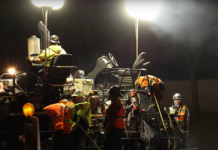“Railroad iron is a magician’s rod, in its power to evoke the sleeping energies of land and water.” — Ralph Waldo Emerson (1803–1882)
Yes, long before the first jalopies coughed and sputtered along our highways and byways, roads of rails crisscrossed the country. The railroad was a part of our country’s historic DNA,and many a city rose up from the iron and steel of the train.
Would Maricopa, Arizona exist without the railroad? For many long-time residents and historians, it’s not a question. It would not.
The early days
The railroad truly is woven into the tapestry of Maricopa, and in Arizona as well.
“The arrival of the railroads was one of the major milestones in Arizona’s history,” said Arizona historian Marshall Trimble. “Because of the hostile environment, mountains and rough country, private enterprise had been minimal. The railroads changed all that.”
Pat Brock, who lived and taught school in Maricopa for decades and has chronicled its definitive history in her book, Reflections of a Desert Town, leaves no question as to whether Maricopa would be here today without the old Iron Horse.
“The very existence of Maricopa as a junction owes its life to the railroad,” Brock said. “Almost every person, directly or indirectly, existed because of the presence of the railroad.”
The first Maricopa
Where the story begins, at least by longitude and latitude, is not even in Maricopa. The first settlement in this area was called Maricopa Wells, which was located just west of Pima Butte and south of the Gila River.
Its history can be traced back to the late 1600s, when a Jesuit missionary named Father Eusebio Francisco Kino explored the Southwest. Father Kino made friends among the Pima Indians who lived along the Gila River, teaching them the basics of farming the land, and raising cattle and horses. Arizona State University Professor Peter Horwath called him the “first cowboy.”
Fact is, and true to its name, Maricopa Wells had water wells, which made it an oasis in the harsh, dry Sonoran Desert.
“Maricopa Wells was there because it was a place with plenty of water and the Native Americans, the Pimas at that time, were very prosperous farmers, very peaceful,” Brock said. “They had 20 settlements up and down the Gila River.”
In the 1800s, Maricopa Wells served as a trading post and relay station for the Butterfield Overland Stage Line. During this time, the U.S. government was plotting to build a railroad to connect the east with the west through this area.
“During the mid-1800s, there were people moving out to the West and they were crying out for communication and a connection with the east,” Brock said. “The plan with the government was to check to see what Arizona was like because it was a barren land and not a lot of population. They wanted to see how they would build the lines across the state.”
Brock said they decided they’d do it through the southern route.
“But instead of building it at Maricopa Wells, they would just move Maricopa on down to the south,” Brock said.
Welcome to Maricopaville
Where the government placed the railroad junction was an area eight miles south of Maricopa Wells called Maricopaville, though this area was known by other names throughout history.
“In all of the records we have, this area was called Phoenix Station, Maricopa Station…there were so many names for it,” Brock said. “So, to distinguish between the two, I called it Maricopaville in the book.”
Maricopaville was located about approximately three miles west of present-day Maricopa. Brock writes in her book that “the U.S. Post Office, the telegraph office and other valuables were moved from Maricopa Wells to Maricopaville in 1879. The Southern Pacific Railroad had just completed laying a railroad line to connect the east with the west at Maricopaville and was ready to build a second branch line from that point to Phoenix.”
Maricopaville was a hotbed of activity from 1879 through the mid-1880s. As a major east-west railroad junction, the town became a player in central Arizona. Hotels and houses, restaurants and saloons sprung up virtually overnight. Brock says that newspapers of the day buzzed about its rapid growth and importance as a hub for passengers and freight from all over the territory.
But Maricopaville’s prosperity would be short-lived.
Make way for Maricopa
The second line, which would connect to Phoenix, spelled the demise of young Maricopaville. The city of Tempe, upon hearing the news of the second rail line coming, protested the route the government planned to us, which would bypass Tempe.
“They said ‘If you’re building a line up to Phoenix, you’re leaving us out; ‘we want to be on the junction, too.’ Tempe was very excited about the railroad coming, and if government money was being used, they felt they needed to be a part of it,” Brock said.
In order to place Tempe on the route, the connecting rail line was moved three miles to the east to where Maricopa is today. By doing so, it would create a direct north-south alignment with Tempe. Maricopa became the new junction for the rail lines.
And what became of Maricopaville? Though records are sketchy, it was reported by one Phoenix newspaper that Maricopaville burned to the ground in 1886.
The old M&P
Building the 35-mile line from Maricopa to Phoenix, which was called the Maricopa and Phoenix Railroad (and later Arizona Eastern Railroad), was challenging from the start.
“What’s interesting about the M&P is that they could build railroads back in those days and easily lay 10 miles of track in one a day,” Brock said. “But it took 8 attempts and 10 years to build that line.”
She said there were many reasons why it took so long to build the line. Some of it was financial, but a big reason was simply the government bureaucracy of the time. The line was eventually completed and the first train pulled out of Maricopa on July 4, 1887.
Now, as the junction of two railroads and the central boarding point for passengers traveling east or west, Maricopa bloomed like a desert flower. At any one time, there might have been as many 250 passengers waiting at the station.
It wasn’t just passengers who climbed aboard at the Maricopa station. Trains now did the heavy lifting for all kinds of freight moving in and out of Salt River Valley: citrus and cotton, cattle and copper, all packed the freight cars on the old M&P. Brock said they shipped a great deal of lumber as well.
“This was the biggest item that was shipped into the Phoenix area because they were building
like night and day,” Brock said.
Be our guest
By the late 1800s, hotels had sprung up in Maricopa. The first and the largest was the Hotel Williams. According to Brock, the Williams family, who owned the hotel, was quite colorful.
“They had a pet bobcat that they kept on a chain at the hotel,” Brock said. The Williams Hotel was destroyed by fire in 1913. Across the tracks, was the Edwards Hotel. Brock says couples would travel by train to Maricopa for their honeymoon, staying at the Edwards.
“Many a happy pair was married in the Phoenix area in the early evening, caught the train to Maricopa for a one-night honeymoon and were back in Phoenix for breakfast the next morning,”
Brock said.
The Deals
Siblings Paul Deal and Marjorie Deal Smith grew up at the Edwards Hotel in the early 1900s. Their father, Art Deal, was a part owner of the hotel, which at that time was the only store and restaurant in town.
Their father was en route to Montana in 1898 when he stepped off the train in Phoenix to deliver a package to a family friend. He never left, ranching for four years, then becoming a well driller, and a fireman and then engineer on the Arizona Eastern Railroad (a branch of the Southern Pacific).
As a railroader, he discovered Maricopa and settled here, becoming a part owner in the major commercial enterprises in the small town.
“Maricopa was the railroad; it had an excellent train station with a water tower and pump house,” Paul said. “It was much better than most stops on the Southern Pacific line because Maricopa was the door to Phoenix. It had the capacity to handle a lot of freight with a long building to load directly onto freight cars.”
The store, hotel and railroad station burned to the ground in August 1931. When Paul and Marjorie’s father retired at age 82, he was “the oldest active railroader in the U.S.,” Marjorie said.
Today, Paul and Marjorie are both in their 80s, but still talk with great fondness of their time growing up in a small town called Maricopa and role the railroad played in its history. “The railroad was the connection that Maricopa needed,” Paul said.
End of the M&P
One era of Maricopa’s railroad history ended on April 15, 1935 when Southern Pacific pulled the track from under the Maricopa and Phoenix Railroad, almost literally.
From the beginning, the M&P had been beleaguered with delays due to flooding, leaving passengers stranded in Maricopa for days while the track was repaired.
“Every time it would rain, it would take out their lines,” Brock said. “The problem was that they built the track too low and the wood was soft and it wasn’t plated, it would wipe the track out.”
It didn’t help that Southern Pacific was looking at building another rail line at Picacho, which would run through Coolidge, Chandler, Mesa, Tempe and Phoenix. Brock wrote: “In 1926, this newly constructed line drove the last nail to seal the coffin of Maricopa as a junction.”
With the Picacho rail line complete, it was only a matter of time. A few years after closing the M&P in 1935, the Southern Pacific tore up the tracks that had once served as an economic pipeline between Maricopa and Phoenix.
Later years
Obviously, Maricopa didn’t die and shrivel up after the demise of the M&P. Passenger trains continued to come from the east and west through the 1950s. In fact, the train took on an almost social identity. There was a sense of glamour, a romantic allure to train travel, and Maricopa was not immune to it.
“Everybody put on their Sunday best when they came to Maricopa, and the congregated under that water tower, and there was a palm tree there,” Brock said.
Today, Union Pacific Railroad and others run more than 40 freight trains daily though the city. Amtrak continues to offer triweekly service, both to the east and west from Maricopa Station.
For Pat Brock, it’s important that Maricopa’s unique place in the history or Arizona and the Southwest not be lost as those who remember it pass from this world.
“I spend most my time working and researching Maricopa’s history. These places we’re talking about, they’re alive today because of these memories.”
Submitted photo


![Shred-A-Thon to take place tomorrow An image of shredded paper. [Pixabay]](https://www.inmaricopa.com/wp-content/uploads/2024/03/shredded-paper-168650_1280-218x150.jpg)






![Elena Trails releases home renderings An image of one of 56 elevation renderings submitted to Maricopa's planning department for the Elena Trails subdivison. The developer plans to construct 14 different floor plans, with four elevation styles per plan. [City of Maricopa]](https://www.inmaricopa.com/wp-content/uploads/2024/04/city-041724-elena-trails-rendering-218x150.jpg)





![Shred-A-Thon to take place tomorrow An image of shredded paper. [Pixabay]](https://www.inmaricopa.com/wp-content/uploads/2024/03/shredded-paper-168650_1280-100x70.jpg)


